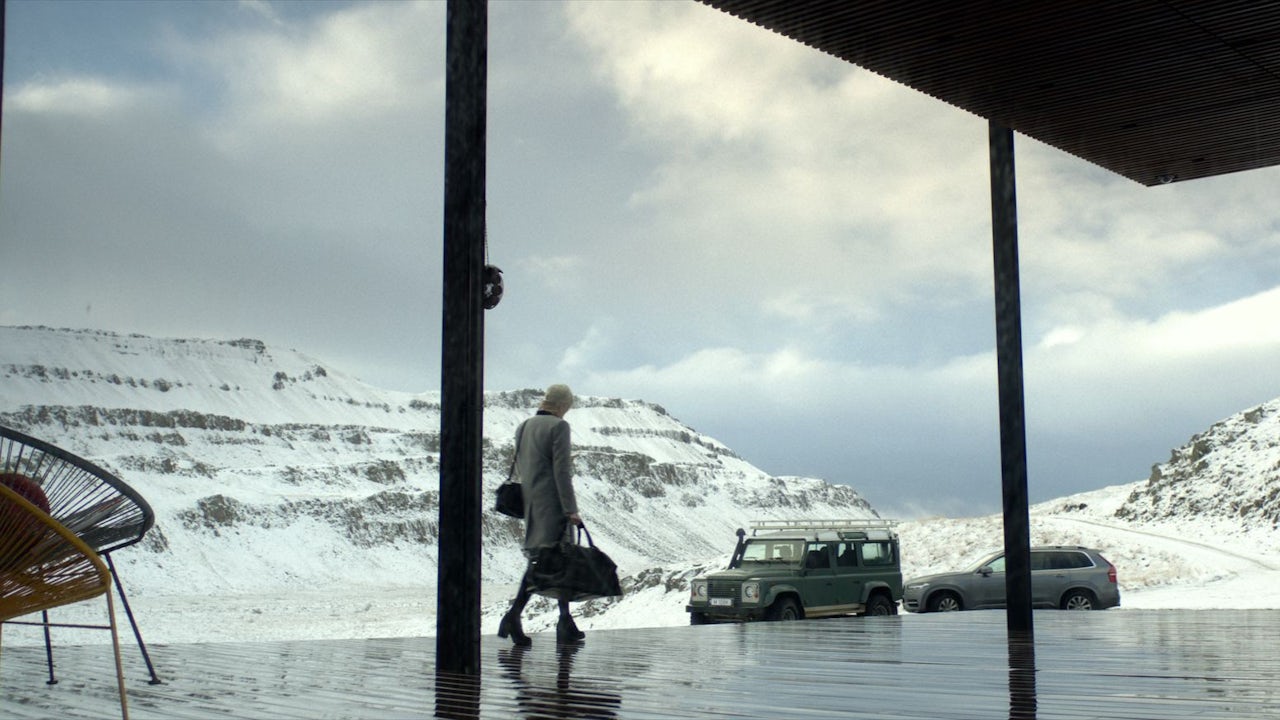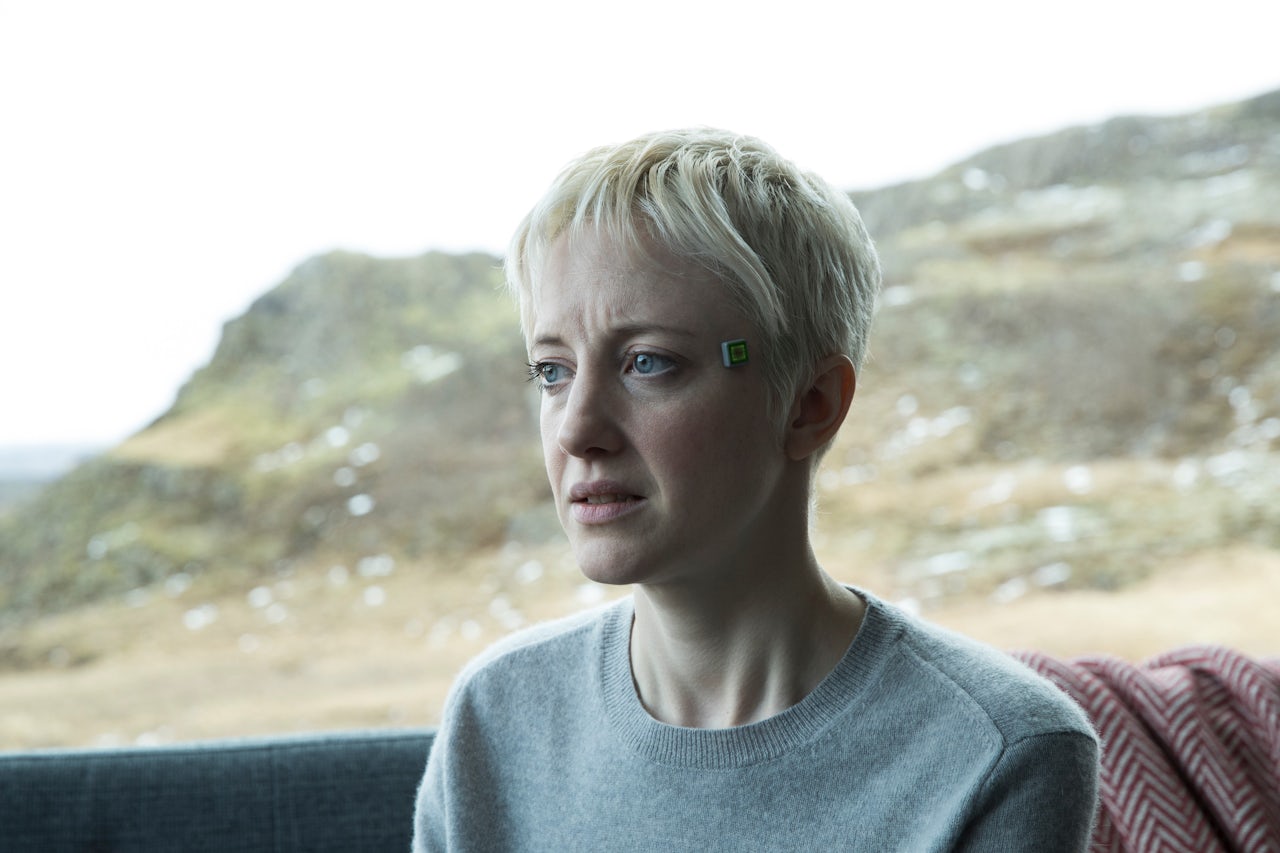A mother, her face gashed and bloodied, screams her daughter’s name in the empty streets of their city neighborhood. A young woman drives through a vista dominated by rubescent mountains, stopping to charge her car beside a seemingly abandoned roadside attraction, the site of her planned revenge. A murderer pauses after her latest killing to puke at the feet of craggy, icy cliffs. Each scene is beautiful, dominated by breathtaking landscapes that at once hold the promise of horror and the threat of loss. Black Mirror has always had its own distinct visual style, sleek, moody, metallically cold. But in Season 4, with its focus on human consciousness — how it can be accessed, transferred, and shared, for better and worse — the scenery in particular stands out, making this the most stunning, and by extension terrifying, season of the Netflix show yet.
The dystopian understanding that runs through all six episodes is that in this reality — one that, in traditional Black Mirror fashion eerily mirrors ours — not even our thoughts and perspectives are our own. The insides of our minds are as vulnerable as any other part of our bodies to the intrusion that technology promises and reassures can’t escape consumer control. It’s an anxiety-inducing premise in and of itself. Aided by the season’s increased use of panoramic shots of settings full of natural splendor and devoid of human-to-human contact, the show has now managed to wordlessly tap into an ever-present modern dread: that modern technology, no matter how advanced, can never kill off the specter of loneliness and isolation. The 1979 Ridley Scott film Alien was marketed with the tagline “In space no one can hear you scream.” In the world of Black Mirror, no one on earth can hear you scream, either. Emptiness is inescapable even as we watch characters have their minds intruded upon. And yet those shots evoking that grim emptiness are too captivating to look away from, unlike the show’s scenes of physical violence and gore meant to shock the viewer into fear.
“Crocodile,” an episode about a woman trying to escape a past crime in the face of a new technology that can tap into people’s memories, draws significant dramatic tension from the craggy, bare landscape on which it is set. Filmed in Iceland, the terror of its premise is underscored by the oftentimes otherworldly (at least for viewers living outside of Iceland) setting that illustrates human isolation, even as human minds are probed, observed, and recorded. Some of the most memorable scenes come when Mia and Shazia, “Crocodile”’s protagonists, are beset by the stunning panoramas, even as they are within the glass walls of Mia’s ultra-modern home. Mossy hills backed by icy cliffs loom over them both as Shazia interviews Mia (using the memory-reading machine) to get to the bottom of an insurance claim, Shazia soon becoming Mia’s next target as she unintentionally stumbles upon memories of her murders past.
In “Metalhead”, filmed mostly on the moors of Dartmoor, England, the isolation of the landscape is used to heighten the terrifying pursuit of the episode’s plot. The first-ever black and white Black Mirror follows its protagonist through stark hills, cliffs, and heaths as she tries to escape a tireless, high-tech killing machine twistedly referred to as a “dog.” As I watched, I couldn‘t help thinking: How would I survive if dropped in such a place, pursued by danger or not? One of the most terrifying situations we guard against each day is finding ourselves stuck anywhere without a working means of communication or at least an outlet where we can reliably charge one. This season of Black Mirror plays on that fear without ever being explicit about it, entertaining the “what if” that appears in the back of our minds every time we leave the house.
With every new season of Black Mirror, there are plenty of jokes to be found about how the show’s message is rather one-note — how everything can be boiled down to “phones are bad” or “3-D televisions are weird” and whatever else will inspire a vague feeling of dread in the viewer as she watches on her phone or 3-D TV. But this new collection really does represent a departure and deepning of the show’s core themes, by focusing on society’s future relationship with the natural world, and by providing the proper cinematic backdrop for everything to play out. It’s easy to think, today, that the only place technology can destroy our brains is at home, but the world out there is being re-mapped, too, in ways that we’ll grapple with in the coming years.
In my favorite episode of the season, “Black Museum”, a young woman named Nish visits a roadside, freakshow-esque collection of technological crimes in order to free her imprisoned father. At one point, the museum’s owner attempts to explain what made pain so addictive to a doctor driven mad by an experimental technology that allows him to feel his patients’ physical sensations without suffering any injury himself. “The fear a patient feels when they’re staring up at that ceiling light, the fear accompanying each sudden jab of agony, he’d come to appreciate that, too,” he says. “It went with the pain. Complemented it like red wine and steak.” It's an apt observation that touches on what makes the show’s eerie landscapes so affecting. Beforehand, we see wide shots of Nish driving to the museum in the arid expanses of Almeria, Spain, where the episode was filmed — inherently dazzling environments where she is completely alone, evoking the foreboding openings to movies like The Shining and Psycho, in which our intrepid protagonists set out to what will be the site of their madness, accompanied only by their thoughts. At the episode’s triumphant end, when Nish has seemingly avenged her family, the camera lingers on the Black Museum as she drives away, suggesting she can finally leave it behind. Back in the empty, solitary world, at least she isn’t alone.




